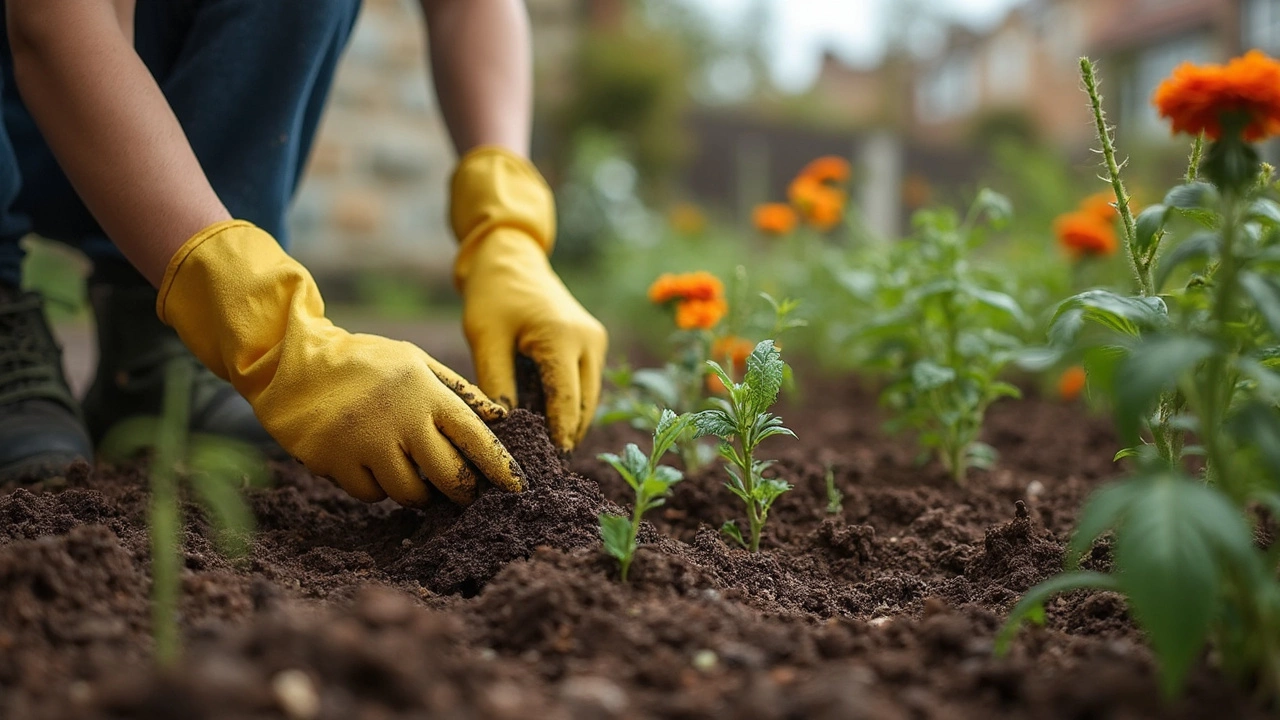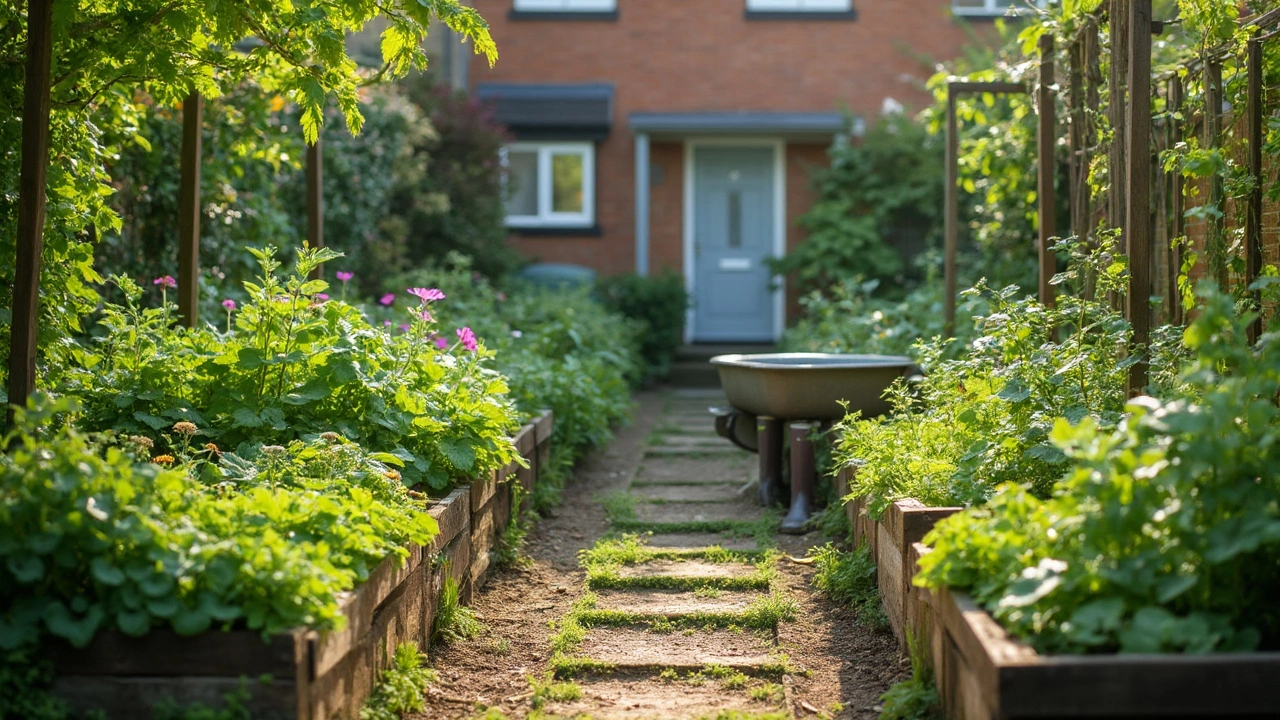Think you need a green thumb or a big budget to build a self sustainable garden? Not true. The secret is setting up a system that pretty much runs itself. You just need some planning and a few oddball tricks—it’s easier than you might expect.
First up, ditch the chemical fertilizers and get your hands on some real dirt. Grab coffee grounds, veggie scraps, and dead leaves, and let them rot in a compost pile. This stuff turns into black gold for your soil and saves you cash.
If your soil looks tired or sandy, try this: dig in some compost, plant a patch of clover, or even sprinkle some worm castings on top. Healthy soil powers up plant roots, keeps moisture in, and gives you a solid start with fewer weeds and pests. Building your soil is way better than dumping store-bought dirt by the bag every year.
- Start with the Right Foundation
- Smart Plant Choices and Companion Planting
- Water Management Made Simple
- Organic Upkeep and Long-Term Success
Start with the Right Foundation
The first thing to get right when building a self sustainable garden is the base: your soil, layout, and compost system. Don't just grab a shovel and start digging. You want a setup that simplifies your life and boosts plant health from day one.
Begin by checking your soil texture. Squeeze a handful; if it sticks together but crumbles with a poke, you’re golden. Clay soils hold water but can drown roots, while sandy soils drain too fast and lose nutrients. Mix in compost to either type and you’ll see big improvements—plants feed off that decaying stuff. Aim for at least 2–3 inches of compost blended into the top six inches of soil.
Now, let’s talk layout. Group your crops by their needs. Sun-lovers together, shade lovers in cooler corners, and keep thirsty plants near your water source. Add some pathways—crushed stone, wood chips, or just grass—so you don’t stomp the beds every time you walk through.
- Test your soil with a kit you can grab at any garden center. You’ll get pH and nutrient info in minutes.
- Start a compost pile or bin in a shady spot. Rotate food scraps, leaves, and shredded paper. A pile turns to good compost in about three to six months, depending on how often you flip it.
- Make raised beds if your ground is rocky or waterlogged—wood frames or reclaimed bricks both work.
Here’s a handy table with dirt basics and what each type needs:
| Soil Type | Drainage | Best Fix |
|---|---|---|
| Clay | Poor | Add compost, sand, gypsum |
| Sandy | Fast | Add compost, mulch, organic matter |
| Loam | Ideal | Maintain with compost |
Never forget: Good compost is the fuel for your entire garden. It adds nutrients, traps water, and brings beneficial bugs and bacteria that do the hard work for you. Once your foundation is set, the rest falls into place with a lot less trouble.
Smart Plant Choices and Companion Planting
The right mix of plants can make or break your self sustainable garden. You want stuff that feeds you, helps each other out, and doesn’t freak out when the weather flips. Tough, homegrown choices like kale, tomatoes, bush beans, and zucchini are great starters—but the magic really happens when you use companion planting.
Companion planting is about putting certain veggies and herbs next to each other so they chase off pests, boost soil nutrients, and grow better together. For example, stick basil next to your tomatoes. The basil keeps bugs away, and you get better-tasting tomatoes. Carrots and onions are another solid pair. Onions confuse the pests that like to chew on carrots, and vice versa.
- Beans, peas—fix nitrogen in the soil, which other plants like corn or squash love.
- Marigolds—act like a natural bug shield against aphids and nematodes.
- Lettuce—can grow under taller crops, helping shade its roots and keep moisture in.
- Radishes—go well with cucumbers and fend off cucumber beetles.
Don’t crowd every inch with just one crop. Mix it up! Pests get confused, disease doesn’t spread as fast, and your space gets used better. A basic companion planting table can help plan out what goes where:
| Plant Friendship | Perfect Partners | Why It Works |
|---|---|---|
| Tomato | Basil, Marigold | Deters pests, improves taste |
| Carrot | Onion, Pea | Pest confusion, nutrient boost |
| Bean | Corn, Squash | Soil nitrogen boost |
| Cucumber | Radish, Nasturtium | Pest control |
If you’re new to this, start small and observe. I once planted tomatoes next to potatoes—bad move, because they fight for nutrients. Don’t be afraid to jot down what works each season. Your garden basically tells you its favorites if you pay attention.

Water Management Made Simple
Most folks waste more water in their gardens than they realize. If you want a self sustainable garden, you’ll need to lock in smart water habits from the start. The truth: your plants only need steady, deep watering—not a daily sprinkle. Less is more, and deeper is better because it pushes roots down, making them tough even during hot spells.
Rainwater is free and actually better for your plants compared to tap water. Here’s a simple setup: hook a rain barrel to your gutter’s downspout. This way, when it pours, you store up gallons for dry days, and you’ll see your water bill drop fast. Put a mesh screen on top to keep bugs and leaves out.
Mulch is one of those hacks most people skip—don’t make that mistake. Covering bare soil with straw, wood chips, or dried grass clippings locks in water and keeps weeds down. Your beds stay cool in the sun, and you won’t need to water nearly as often.
Want to know what works best in different parts of your garden? Check this table for the main options and their water saving impact:
| Water Saving Strategy | Approx. Water Saved (per season) | Bonus Benefit |
|---|---|---|
| Rain Barrel | 1,300 gallons | Collects free, clean water |
| Mulch (2 inches) | Up to 25% less evaporation | Fewer weeds |
| Drip Irrigation | 30-50% less water used | Direct-to-root moisture |
If you’ve got the budget, install drip irrigation with timers. These don’t break the bank and really target the roots so nothing’s wasted. For small spaces, even soaker hoses work wonders. Set them up in the morning and run just enough to keep the soil damp, not soggy.
Don’t forget about choosing the right plants. Some veggies—like squash, beans, and chard—tolerate dry spells better. If you see a lot of runoff or your bed gets swampy, add organic matter or dig some channels to guide water straight to your plants. Working smarter with water means less work for you and a lot more food from your garden.
Organic Upkeep and Long-Term Success
Once your garden is off the ground, the real trick is keeping it thriving with minimal effort. That means sticking to organic habits—no harsh sprays or weird chemicals. Instead, rely on nature. Healthy plants don’t just happen; they’re the result of smart routines and a little patience.
For starters, pest control doesn’t have to mean store-bought bug killers. Try these moves:
- Hand-pick pests like tomato hornworms early in the morning—they’re slow then and easy to spot.
- Set out saucers of beer to trap slugs; it really works.
- Invite helpful bugs like ladybugs and lacewings by growing dill, fennel, or marigolds nearby.
Mulching is your low-effort hero. Pile up leaves, straw, or wood chips around your plants. Mulch smothers weeds, keeps the ground cool, and locks in water. This tiny habit saves hours of backbreaking weeding and watering.
Rotation is another must. Each year, shift families of veggies—like moving your tomatoes to where your beans grew last summer. Crop rotation breaks up cycles of soil pests and diseases, and keeps nutrients balanced.
Here’s the thing: keeping a self sustainable garden isn’t just about the short term. You want a system that lasts for years. Don’t forget about simple record keeping. Use a notebook or a garden app to jot down what you plant, what works, and what flops. You’ll spot patterns, plan better next year, and waste less money.
Organic gardening is gaining real steam. Almost 26% of Americans who garden now avoid synthetic pesticides entirely, according to a 2023 National Gardening Survey. That way, your food is cleaner, safer, and honestly tastes fresher.
| Organic Method | Estimated Time Saved Per Season | Extra Benefits |
|---|---|---|
| Mulching | 8-20 hours | Less watering, fewer weeds |
| Composting | — | Free fertilizer |
| Hand-picking pests | Varies | No chemical residue |
Stick with the small stuff, pay attention once a week, and your garden will run smoother every single year. If anything gets out of hand, just double down on the basics: good compost, lots of mulch, and let nature help out. It’s all about building habits that make life easier, not harder.
